Explore the mesmerizing allure of Punjabi jewellery. Adorned with vibrant colours and intricate designs, each piece tells a story of heritage and grace, captivating hearts and igniting imaginations
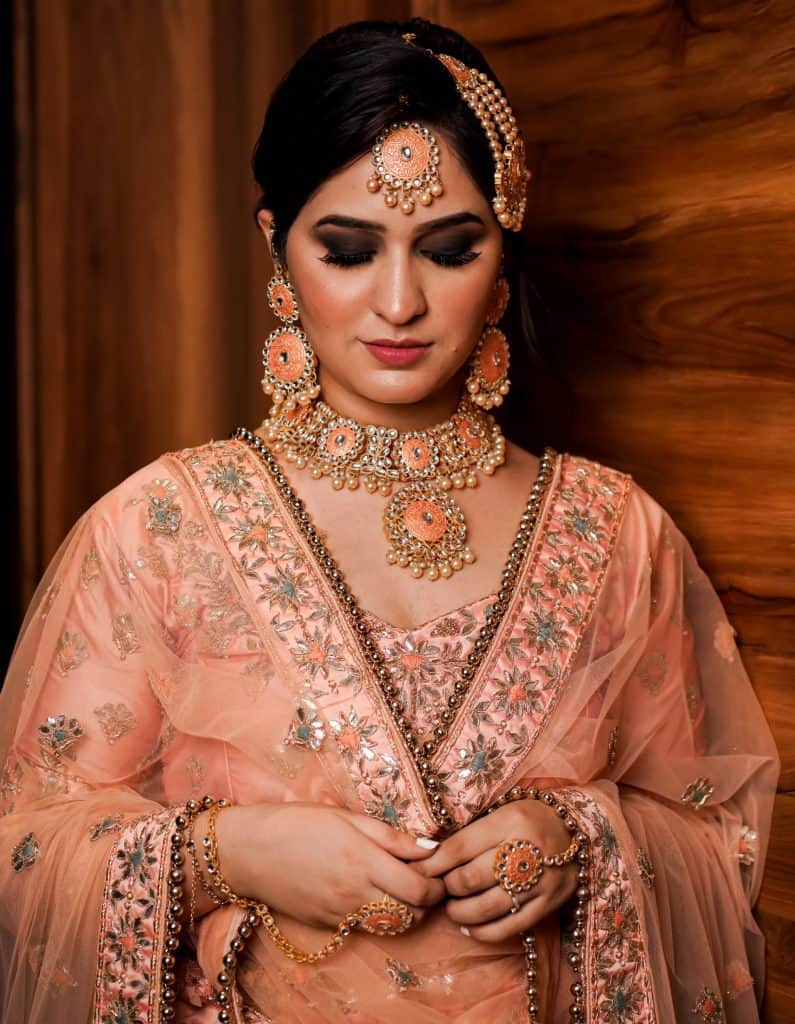
Punjabi jewellery, renowned for its intricate designs, vibrant embellishments, and deep symbolic meanings, is not just an accessory but a testament to the region’s history, spirituality, and the celebratory nature of its people. From the elegance of the Tikka to the grandeur of the Choker, Punjabi jewellery offers a glimpse into the soul of Punjab, reflecting the pride, beauty, and undying spirit of its traditions.
Punjabi Jewellery – rich traditions and history
Punjab, a vibrant state in India renowned for its rich traditions and history, holds a special place in the hearts of its people, known as Punjabis, wherever they may reside across the globe. Despite their global journeys, Punjabis maintain a deep connection to their cultural heritage and roots, which is beautifully reflected in their traditional Jewellery.
The essence of Punjabi Jewellery’s cultural legacy shines through its ornate Jewellery, cherished by both men and women alike. Beyond adornment, Jewellery holds significant social and economic importance in Punjabi society. It serves as both an investment and a safeguard for unforeseen circumstances, embodying notions of wealth and prosperity.
In Punjab, the exchange of jewellery holds special significance, especially during weddings, where it becomes an enduring symbol of love and commitment. Women, in particular, treasure their Jewellery not only for its beauty but also for the cultural and religious significance attached to each piece.
From intricately designed necklaces to elegant bangles, the array of ornaments worn by Punjabis reflects the diversity and depth of their cultural heritage. Each piece tells a story, carrying with it centuries of tradition and symbolism deeply ingrained in the Punjabi psyche.
Let’s explore some traditional Punjabi jewellery
Saggi Phull
In the vibrant world of Punjabi culture, one can’t help but be captivated by the exquisite Saggi Phul, a renowned piece of traditional jewellery adorning the women of Punjab during their spirited Giddha performances, a beloved folk dance. This striking head stud serves as a prominent support for the Punjabi Phulkari or dupatta, along with other ornate accessories. Essential to any Punjabi jewellery collection, the Saggi Phul embodies the essence of grace and heritage.
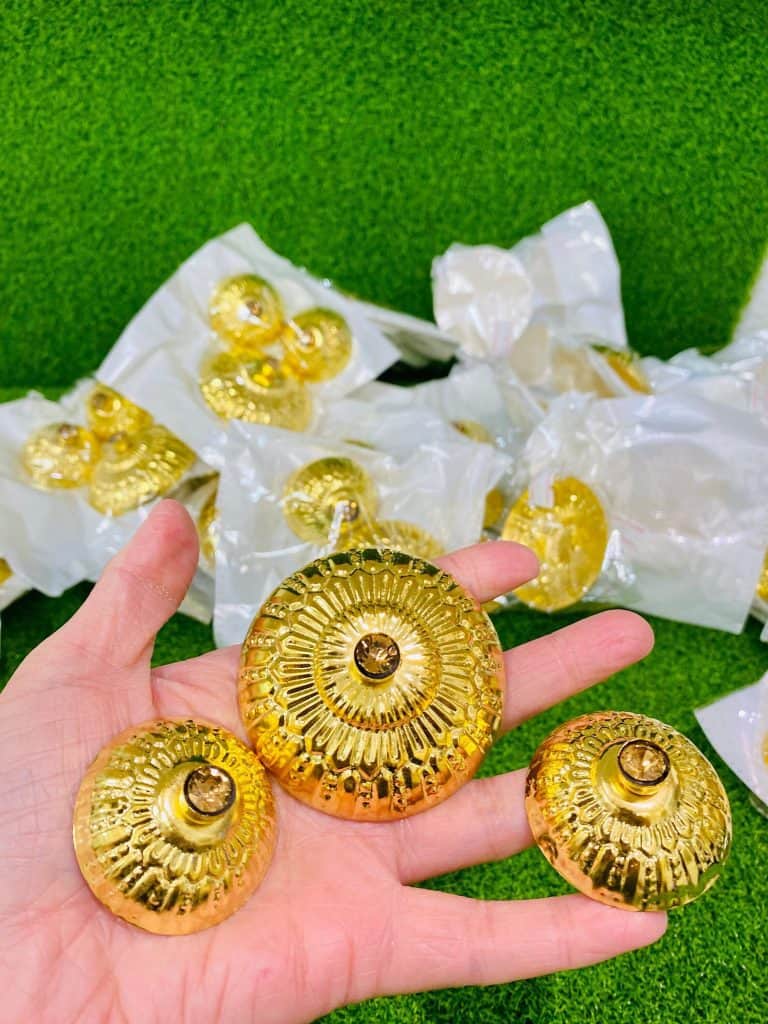
Punjabi jewellery holds multifaceted significance, serving not only as investments but also as potent symbols of strength and femininity. Each ornament, with its nuanced variations in size and pattern, earns a distinct name, reflecting the meticulous craftsmanship and cultural depth of Punjabi adornments. For instance, the Saggi Phul transforms into the Saggi Uchhi with the addition of a colourful stone at its apex, exuding an aura of elegance and charm.
Furthermore, the Saggi Phul evolves into the enchanting Motianwali Sagi, adorned with numerous spherical beads delicately attached along its perimeter with silver chains, evoking a sense of opulence and tradition. With subtle alterations, such as in the case of the Saggi Chandiari, the jewellery takes on new forms, each carrying its own unique allure and cultural significance within the rich tapestry of Punjabi heritage.
Sarpech (Turban ornament)
The Sarpech, alternatively referred to as an aigrette, holds a distinguished place in the cultural attire of significant Hindu, Sikh, and Muslim princes. Its name originates from the combination of two words: “sar,” meaning “head” or “front,” and “pech,” signifying “screw.” This etymology gives the term “sarpech” a direct translation of “that which is screwed onto the front (of the turban).”
This ornate headpiece is not merely a decorative accessory but a symbol of power and prestige, often worn by nobility and royalty to accentuate their regal appearance. Crafted with meticulous detail and adorned with precious gemstones, the sarpech exemplifies the opulence and grandeur associated with princely attire.

Throughout history, the sarpech has served as a marker of social status and lineage, with its design and embellishments reflecting the wearer’s rank and heritage. From elaborate peacock motifs to intricate floral patterns, each sarpech tells a story of tradition and heritage, embodying the rich cultural tapestry of South Asia.
Today, the sarpech continues to be cherished not only for its aesthetic appeal but also for its historical significance, serving as a tangible link to the glorious past of princely states and dynasties and also now being worn by Punjabi grooms popularly.
Vaaliyan or Baaliyan
Punjabi women adorn themselves with traditional large ring-shaped earrings crafted from precious metals such as gold or silver, known as Bali or Vaaliya. These iconic earrings hold a special place in Punjabi culture, symbolizing not just beauty but also tradition and heritage.
The intricate designs and craftsmanship of Bali or Vaaliya reflect the rich cultural tapestry of Punjabi Jewellery, with each piece often showcasing elaborate patterns and motifs inspired by nature, geometric shapes, or religious symbols. These earrings serve as more than just accessories; they are cherished heirlooms passed down through generations, carrying with them stories of familial bonds and shared memories.
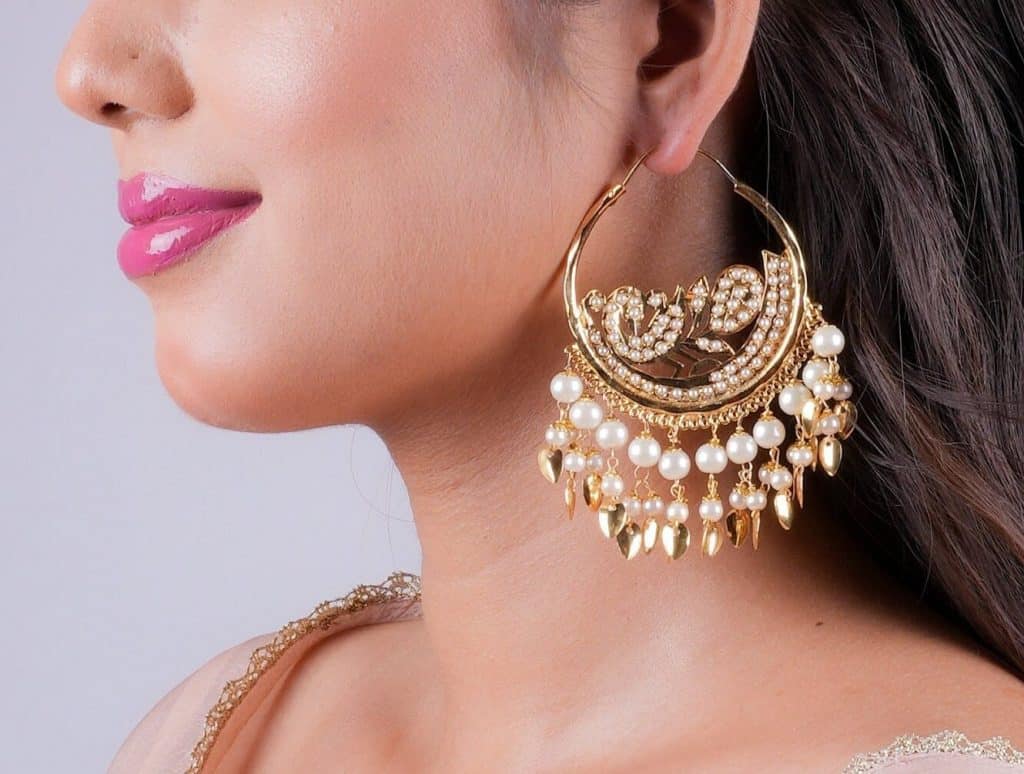
Beyond their aesthetic appeal, Bali or Vaaliya holds deeper significance in Punjabi society. They are worn on auspicious occasions such as weddings, festivals, and religious ceremonies, signifying celebration, prosperity, and spiritual connection. Moreover, these earrings symbolize the strength and resilience of Punjabi women, who embody grace and elegance while navigating the complexities of life.
In essence, Bali or Vaaliya earrings are not merely adornments but tangible expressions of Punjabi identity, embodying the cultural richness, traditions, and values cherished by generations past and present.
Kaintha
The Kaintha enjoyed a revered status among men, fashioned meticulously from authentic gold metal, signifying not just adornment but also social standing and prestige. However, as societal norms and fashion trends shifted over the centuries, the Kaintha transformed its significance and usage. Today, it is primarily reserved for special cultural events and celebrations, such as lively Bhangra performances or spirited dance competitions.
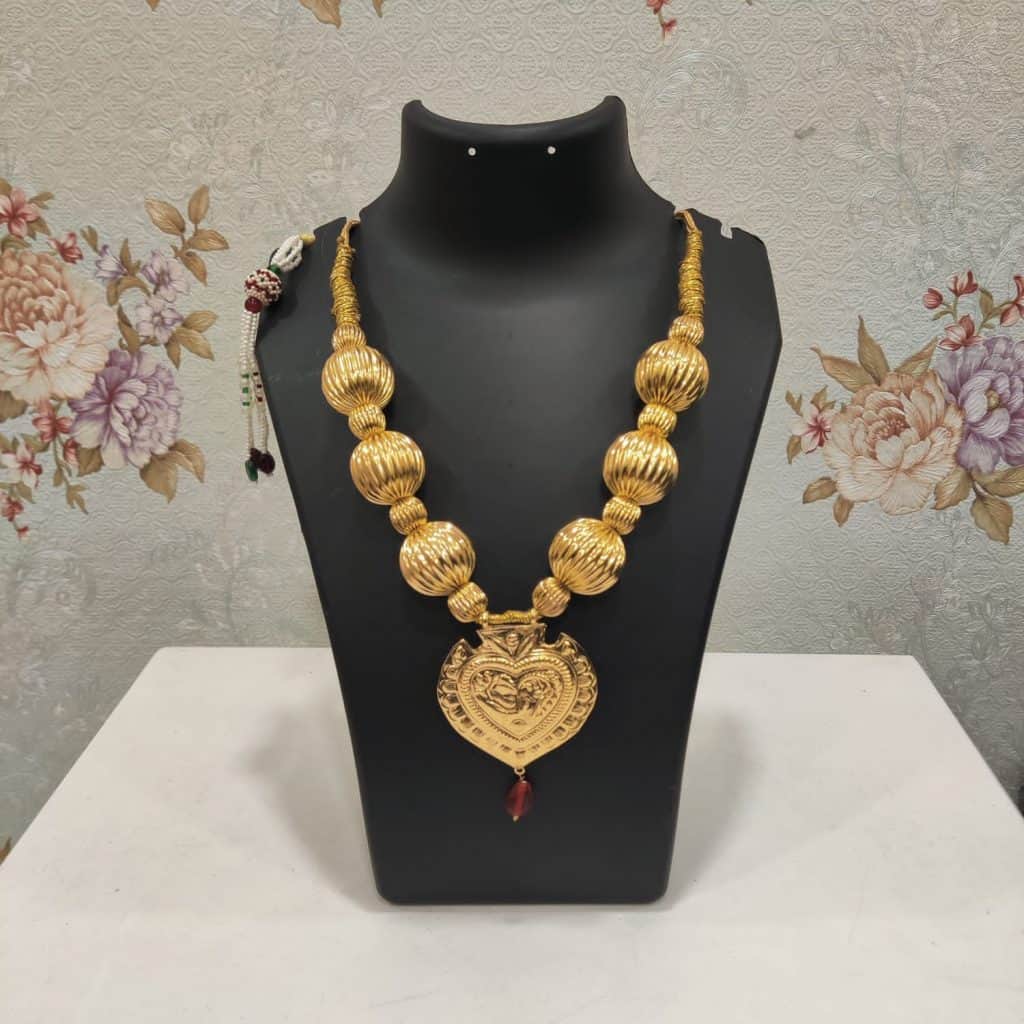
The Kaintha remains an emblematic accessory deeply intertwined with Punjabi folk dance traditions. Its distinctive design typically includes substantial heavy metal patches intricately embellished with vibrant beads, often suspended below the beard of the wearer. This unique ornamentation not only adds a touch of splendour to the attire but also serves as a visual representation of the rich cultural heritage and vitality of Punjab.
While its role may have evolved, the essence of the Kaintha as a symbol of tradition and community pride endures, captivating audiences with its timeless allure and evoking a sense of nostalgia for the bygone eras of splendour and tradition.
Hath Phool
Haath Phool, also known as Hath Panja, is a traditional bridal accessory deeply rooted in Indian culture. Typically worn by Indian brides, this ornate adornment combines elements of wrist bracelets and rings, with designs often featuring a central medallion connected to the wrist by delicate chains or strands of beads.
The medallion, referred to as the ‘phool’ or flower, rests elegantly on the back of the hand, while rings adorn each finger, sometimes including a mirror ring known as ‘arsi’. Originating from Persia and introduced to India by the Mughal Empire, Haath Phools hold significant cultural symbolism and aesthetic appeal.
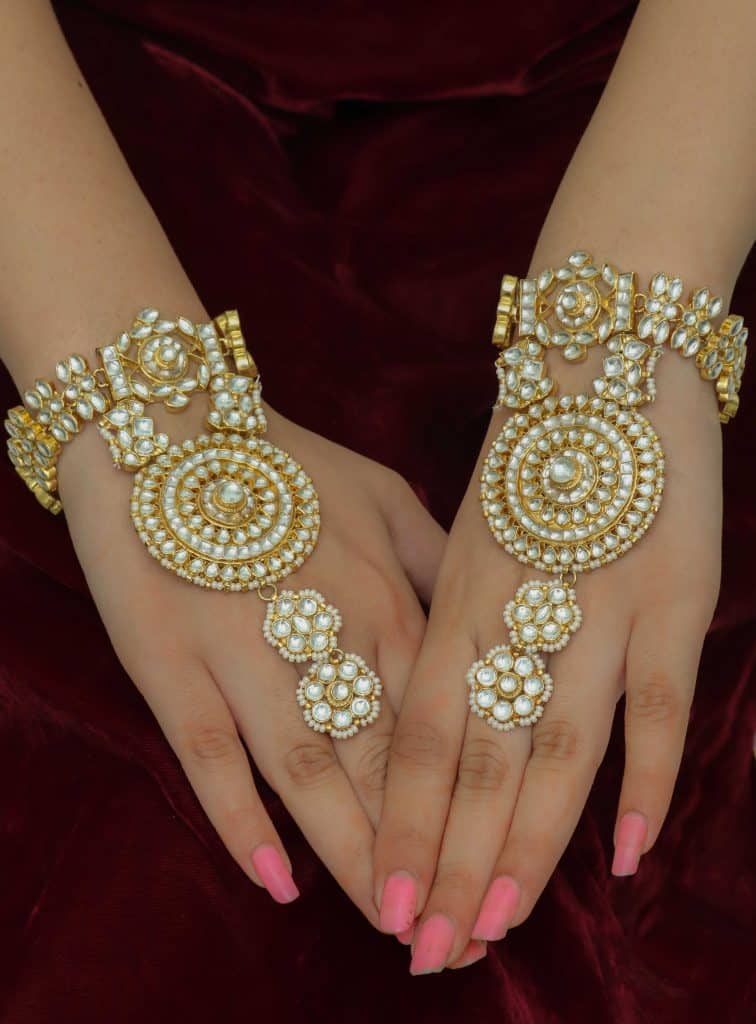
Referred to alternatively as hath kamal or hand chain, and hath panja, the name may vary based on religious and regional distinctions. Over time, Hathphool Designs has evolved, offering a diverse array of styles that have garnered widespread popularity.
What contributes to the enduring appeal of hathphool is its inclusive nature, transcending religious boundaries to be embraced by Hindu, Sikh, and Muslim women alike. This cultural fusion and universal allure have cemented the haath phool’s status as a beloved and cherished accessory in Indian bridal attire.
Choker
The choker, an integral part of Punjabi jewellery, has undergone a transformative journey in symbolism and fashion over the centuries.
Its origins trace back thousands of years to civilizations like the Sumer Empire in Mesopotamia and Ancient Egypt, as documented by the National Jeweler. Throughout history, the choker has experienced waves of popularity, notably during the 18th century, late 19th century, early 20th century, the 1960s-70s, the ’90s, and recent times.
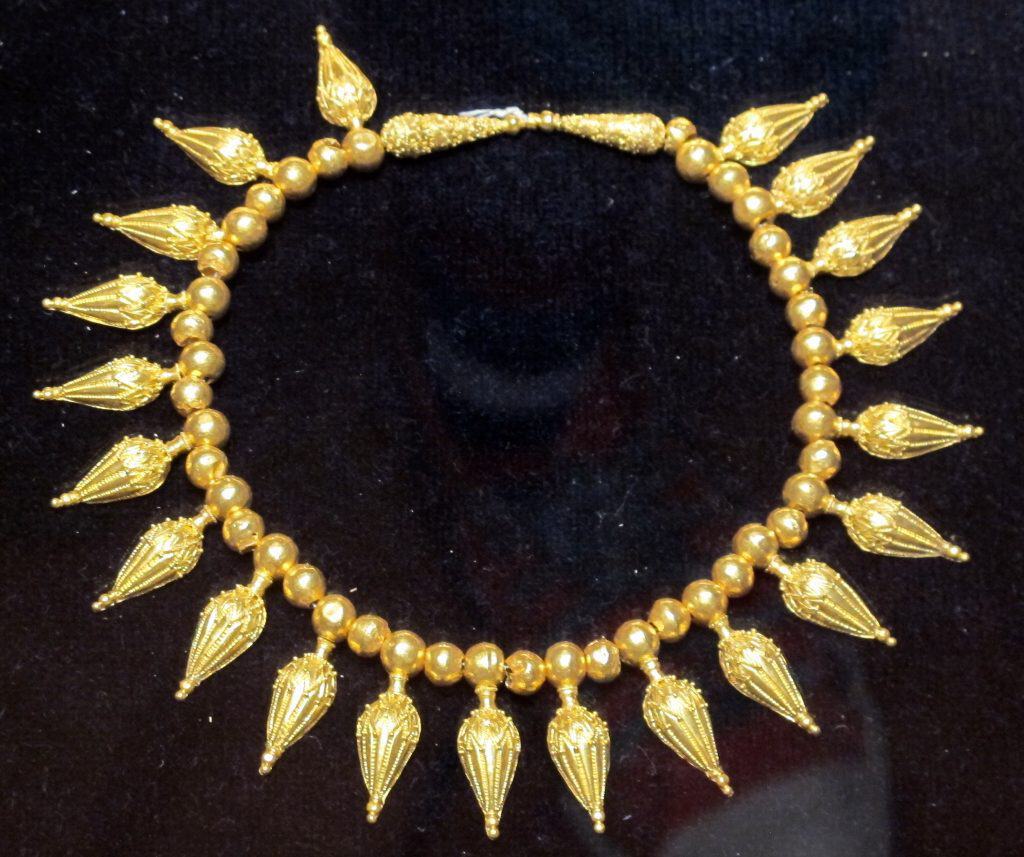
Despite fading from fashion for a period, the choker has made a resurgence due to its undeniable allure. Positioned just below the neck, accentuating its elegance, chokers are now favoured by women at ceremonial events and weddings. Crafted from materials like Gold, Kundan, or Polki, choker sets come in a variety of designs, each exuding its sense of opulence or subtlety, catering to diverse styles and preferences.
As Punjabis continue their global journeys, the allure of Punjabi jewellery serves as a steadfast reminder of their cultural identity and collective pride. In each exquisite piece, the spirit of Punjab shines brightly, echoing through generations and across continents, a timeless tribute to a heritage that transcends borders and resonates in the hearts of all who cherish it.
Read more: Latest



